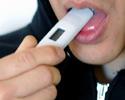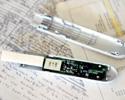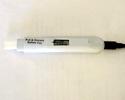
Recently on Cyclingnews.com |
*Special* April 1, 2007, Tech Feature: New technology aids WADA in anti-doping efforts
WADA says: 'suck on this' in the war against doping

|
A new tool rumored to have been developed by the Where Are the Drugs Agency (WADA) promises to take the battle against doping to a new level. Cyclingnews Senior Tech Advisor Dr Kim Lang gained exclusive access to unnamed agency insiders that insist that dopers now have nowhere to hide.
Carbon fiber frames and components are not the only realms of cycling that have benefited from recent advances in nanotechnology. Engineers at the World Anti-Doping Agency (WADA) are said to have employed the latest advances to develop a new testing apparatus that officials (unofficially) claim will clean up the sport now and forever.
In spite of its compact dimensions, the new as-yet-unnamed tester packs a serious punch that belies its innocuous appearance. The small handheld device closely resembles a digital thermometer, and coincidentally, is used in much the same manner: the rider in question simply places the tester in their mouth and waits approximately 30 seconds. At that point, the device will have accumulated enough data to confirm a positive or negative doping result, which is clearly displayed in a highly legible LCD panel on the unit's front face.

|
Cyclingnews' anonymous sources at WADA adamantly claim that the unit has been rigorously tested both in the lab and in the field, and is "absolutely foolproof with a 100% accuracy rate and zero chance of false positives. We have completely eliminated human error from the equation and have made the testing protocol truly mobile for the first time in the history of cycling. No longer can results be deemed questionable for having been performed by a particular technician, or at a particular lab. Computers don't lie."
The credit for that remarkable track record goes to a revolutionary microchip embedded on a printed circuit board (PCB) inside the unit's tidy plastic housing. The chip employs the latest developments in nanotechnology and biomaterials that yield unprecedented microdetection levels as well as 100% biospecificity. Thanks to its built-in memory, the unit can also immediately cross-reference the obtained sample with all banned substances identified by the UCI and WADA, and a convenient USB interface allows for instant firmware updates via any computer connected to WADA's internal mainframe.

|
That mainframe will store all test data for future comparisons with newly discovered performance-enhancing materials. While the computer interface would normally create a point of concern for some, WADA claims that the system is completely impervious to unwanted outside interference thanks to close development of the firmware with US-based partner Microsoft. The case itself is also sealed with a tamper-evident bond.
To help ensure that the tests are properly administered, riders will be tested right on the start line, in plain view of the public and media. According to the anonymous source, "All the rider has to do is stick out their tongue. The process is very discreet and there is no opportunity for a rider to provide an altered or foreign sample."
WADA has not abandoned its controversial tendencies, though, as the agency is so confident in its new methodology that it says there is no longer any need whatsoever to confirm results with 'B' samples: "We're right, and we know we're right, and we're always right, so there's no room for argument."
The new device will also employ an integrated Bluetooth wireless transmitter that instantly sends all positive results to the administering tester's laptop computer. From there, details of the positive result (including rider and team name, identifying number, and banned substance detected) are then sent to an official WADA server which finally distributes the information via SMS and email to all users that will have subscribed to a new fee-based service.

|
As one would expect, WADA incurred exorbitant costs in the research and development for the new device, but the agency will use this fee-based service to help recover its costs. Team managers, media outlets, and even the riders themselves will be able to sign up for the service that has been tentatively dubbed Proof-Positive Messaging Service, or PMS. Subscription costs were not settled at the time of this writing, but WADA insiders are rumored to have said that it will be "rather expensive, but much cheaper than the consequences of a positive result."
Moreover, WADA is so confident in its new protocol that it has revised the current two-year suspension policy to what is sure to be a monumentally controversial instant lifetime ban from the sport, active from the moment the positive result is displayed. Riders will still have the opportunity to appeal the decision, but WADA insiders coyly added that, "Guilty parties can spend the time and money to appeal if they so desire, but if they thought the process was difficult before, wait until this new test is fully implemented."

|
WADA claims the new device is easy and cheap to mass-produce, and production has already begun in an undisclosed facility ironically located in Lance Armstrong's backyard of Austin, TX. WADA has not officially announced when the new tester would be employed, but insist that it will be "very soon, quite possibly as early as the Ronde van Vlaanderen in Belgium on April 8."
Photography
For a thumbnail gallery of these images, click here
Images by Jonathan Devich/epicimages.us
- This harmless looking device is actually WADA's newest tool in the war against doping.
- The heart of WADA's new tester is a patented microchip that employs the latest advances in nanotechnology and biomaterials to yield a reported 100% accuracy rate.
- A clearly legible digital 'POSITIVE' or 'NEGATIVE' readout indicates guilt or innocence.
- The unit's embedded firmware can be easily updated via a USB cable connected to any computer on WADA's network.
- WADA officials may be seen carrying these boxes of doping tests at an upcoming event. Guilty riders will now be subject to immediate lifetime bans from the sport.
- Application of the new test is fast and foolproof : just hold the tester in your mouth (or on your tongue) for 30 seconds and the device does the rest.

